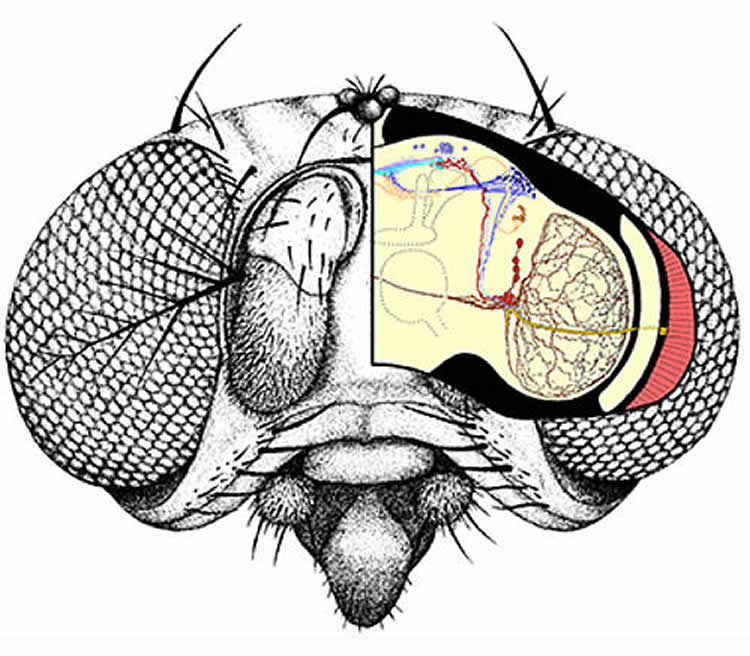Summary: Researchers have discovered what triggers drosophila to extend their midday naps.
Source: University of Würzburg.
Fruit flies’ activity peaks especially in the morning and late afternoon. The insects extend their midday siesta on long summer days. Researchers from the University of Würzburg have now found out what triggers this behaviour. A miniature pair of eyelets also discovered in Würzburg in the late 80s plays a crucial role in this context.
In 1989, the Würzburg biologists Alois Hofbauer and Erich Buchner reported a surprising finding in the journal “Naturwissenschaften”: They had identified a new pair of eyelets in drosophila unknown until then. The fruit fly was considered an important model organism for zoologists and geneticists even back then with scores of scientists showing an interest in the tiny insect. But they had all failed to detect the additional eyes – no wonder given their microscopic size: Each eyelet consists of just four photoreceptor cells.

In spite of this, the Hofbauer-Buchner eyelets seem to play a major role in the life of drosophila. A study conducted by scientists from the University of Würzburg with colleagues from the University of Michigan and the University of Bristol has come to this conclusion.
Drosophila’s activity peaks in the morning and in the late afternoon and they rest during the hottest time of the day. The tiny sensory organs evidently influence when this midday siesta ends. “On long summer days, they delay the onset of the afternoon activity phase,” explains Professor Charlotte Helfrich-Förster from the University of Würzburg’s Biocenter.
Hardwired in the fly’s brain
The scientist has studied drosophila’s circadian rhythms for years. In the current study, her research team has been able to show for the first time that the Hofbauer-Buchner eyelets are wired to a clock neuron network in the flies’ brain: Nerve fibres run directly from the eyelets to two groups of clock neurons. One of them is responsible for the morning activity whereas the other influences the evening activity.
“At daybreak, light falls onto the eyelets,” Helfrich-Forster details. “This light input triggers the production of the two neurotransmitters histamine and acetylcholine. We suppose that acetylcholine activates the neurons relevant for morning activity. At the same time, the histamine seems to indirectly inhibit the circadian clock for the evening peak phase thereby extending the phase of inactivity.” Hence, the Hofbauer-Buchner eyelets are part of a complex network that governs drosophila’s sleep/activity rhythm.
Mammalian clock similar to that of flies
Another reason why the findings are interesting is because the circadian clocks of animals have changed comparably little in the course of evolution. “Mice, for example, have a neuronal clock network in their brains that shares many similarities with that of the fruit fly,” Helfrich-Förster emphasises. “Therefore, drosophila allows us to get deep insights into the circadian clock of mammals and probably into that of humans, too.”
Source: Frank Luerweg – University of Würzburg
Image Source: This NeuroscienceNews.com image is credited to Helfrich-Förster.
Original Research: Abstract for “A Neural Network Underlying Circadian Entrainment and Photoperiodic Adjustment of Sleep and Activity in Drosophila” by Matthias Schlichting, Pamela Menegazzi, Katharine R. Lelito, Zepeng Yao, Edgar Buhl, Elena Dalla Benetta, Andrew Bahle, Jennifer Denike, James John Hodge, Charlotte Helfrich-Förster, and Orie Thomas Shafer in Journal of Neuroscience. Published online August 31 2016 doi:10.1523/JNEUROSCI.0992-16.2016
[cbtabs][cbtab title=”MLA”]University of Würzburg. “Light Causes Flies to Take a Longer Midday Nap.” NeuroscienceNews. NeuroscienceNews, 16 September 2016.
<https://neurosciencenews.com/light-sleep-neuroscience-5057/>.[/cbtab][cbtab title=”APA”]University of Würzburg. (2016, September 16). Light Causes Flies to Take a Longer Midday Nap. NeuroscienceNews. Retrieved September 16, 2016 from https://neurosciencenews.com/light-sleep-neuroscience-5057/[/cbtab][cbtab title=”Chicago”]University of Würzburg. “Light Causes Flies to Take a Longer Midday Nap.” https://neurosciencenews.com/light-sleep-neuroscience-5057/ (accessed September 16, 2016).[/cbtab][/cbtabs]
Abstract
A Neural Network Underlying Circadian Entrainment and Photoperiodic Adjustment of Sleep and Activity in Drosophila
A sensitivity of the circadian clock to light/dark cycles ensures that biological rhythms maintain optimal phase relationships with the external day. In animals, the circadian clock neuron network (CCNN) driving sleep/activity rhythms receives light input from multiple photoreceptors, but how these photoreceptors modulate CCNN components is not well understood. Here we show that the Hofbauer-Buchner eyelets differentially modulate two classes of ventral lateral neurons (LNvs) within the Drosophila CCNN. The eyelets antagonize Cryptochrome (CRY)- and compound-eye-based photoreception in the large LNvs while synergizing CRY-mediated photoreception in the small LNvs. Furthermore, we show that the large LNvs interact with subsets of “evening cells” to adjust the timing of the evening peak of activity in a day length-dependent manner. Our work identifies a peptidergic connection between the large LNvs and a group of evening cells that is critical for the seasonal adjustment of circadian rhythms.
SIGNIFICANCE STATEMENT In animals, circadian clocks have evolved to orchestrate the timing of behavior and metabolism. Consistent timing requires the entrainment these clocks to the solar day, a process that is critical for an organism’s health. Light cycles are the most important external cue for the entrainment of circadian clocks, and the circadian system uses multiple photoreceptors to link timekeeping to the light/dark cycle. How light information from these photorecptors is integrated into the circadian clock neuron network to support entrainment is not understood. Our results establish that input from the HB eyelets differentially impacts the physiology of neuronal subgroups. This input pathway, together with input from the compound eyes, precisely times the activity of flies under long summer days. Our results provide a mechanistic model of light transduction and integration into the circadian system, identifying new and unexpected network motifs within the circadian clock neuron network.
“A Neural Network Underlying Circadian Entrainment and Photoperiodic Adjustment of Sleep and Activity in Drosophila” by Matthias Schlichting, Pamela Menegazzi, Katharine R. Lelito, Zepeng Yao, Edgar Buhl, Elena Dalla Benetta, Andrew Bahle, Jennifer Denike, James John Hodge, Charlotte Helfrich-Förster, and Orie Thomas Shafer in Journal of Neuroscience. Published online August 31 2016 doi:10.1523/JNEUROSCI.0992-16.2016






